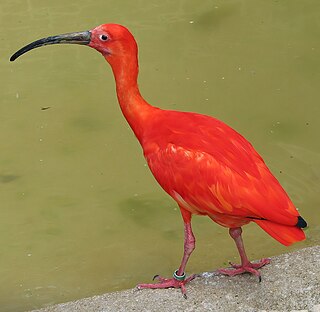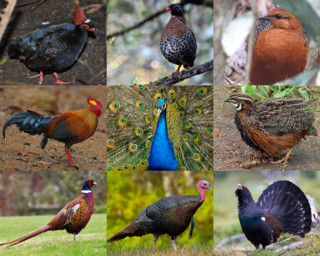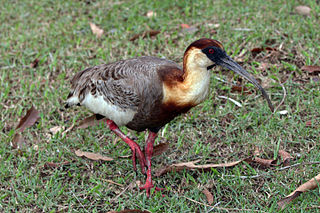
Falcons are birds of prey in the genus Falco, which includes about 40 species. Some small species of falcons with long, narrow wings are called hobbies, and some that hover while hunting are called kestrels. Falcons are widely distributed on all continents of the world except Antarctica, though closely related raptors did occur there in the Eocene.

The ibis are a group of long-legged wading birds in the family Threskiornithidae that inhabit wetlands, forests and plains. "Ibis" derives from the Latin and Ancient Greek word for this group of birds. It also occurs in the scientific name of the western cattle egret mistakenly identified in 1757 as being the sacred ibis.

Spoonbills are a genus, Platalea, of large, long-legged wading birds. The spoonbills have a global distribution, being found on every continent except Antarctica. The genus name Platalea derives from Ancient Greek and means "broad", referring to the distinctive shape of the bill. Six species are recognised, which although usually placed in a single genus have sometimes been split into three genera.

The family Threskiornithidae includes 36 species of large wading birds. The family has been traditionally classified into two subfamilies, the ibises and the spoonbills; however recent genetic studies have cast doubt on this arrangement, and have found the spoonbills to be nested within the Old World ibises, and the New World ibises as an early offshoot.

The Phasianidae are a family of heavy, ground-living birds, which includes pheasants, partridges, junglefowl, chickens, turkeys, Old World quail, and peafowl. The family includes many of the most popular gamebirds. The family includes 185 species divided into 54 genera. It was formerly broken up into two subfamilies, the Phasianinae and the Perdicinae. However, this treatment is now known to be paraphyletic and polyphyletic, respectively, and more recent evidence supports breaking it up into two subfamilies: Rollulinae and Phasianinae, with the latter containing multiple tribes within two clades. The New World quail (Odontophoridae) and guineafowl (Numididae) were formerly sometimes included in this family, but are now typically placed in families of their own; conversely, grouse and turkeys, formerly often treated as distinct families, are now known to be deeply nested within Phasianidae, so they are now included in the present family.

The northern bald ibis, hermit ibis, or Waldrapp is a migratory Old World ibis found in open areas such as grasslands, rocky mountains, and semi-deserts, often close to running water. This 70–80 cm (28–31 in) glossy black ibis, which, unlike many members of the ibis family, is non-wading, has an unfeathered red face and head, and a long, curved red bill. It breeds colonially on coastal or mountain cliff ledges, where it typically lays two to three eggs in a stick nest, and feeds on lizards, insects, and other small animals.

The green ibis, also known as the Cayenne ibis, is a wading bird in the ibis family Threskiornithidae. It is the only member of the genus Mesembrinibis.

Actitis is a small genus of waders, comprising just two very similar bird species.

Lagopus is a small genus of birds in the grouse subfamily commonly known as ptarmigans. The genus contains three living species with numerous described subspecies, all living in tundra or cold upland areas.

The southern bald ibis is a large bird found in open grassland or semi-desert in the mountains of southern Africa. Taxonomically, it is most closely related to its counterpart in the northern regions of Africa, the waldrapp. As a species, it has a very restricted homerange, limited to the southern tips of South Africa in highland and mountainous regions.

Proardea is an extinct genus of heron, containing two species, Proardea amissa and Proardea? deschutteri from the Borgloon Formation of Belgium. It stood about 70 cm tall and was very similar to a modern heron in shape. The species is known from rather fragmentary fossils in the area of Quercy, France; dated remains are from Pech Desse, a Late Oligocene locality, but the original fossil, a single right tarsometatarsus, isn't precisely dated and may have come from deposits as early as Late Eocene in age.

The buff-necked ibis, also known as the white-throated ibis, is a fairly large ibis found widely in open habitats of eastern and northern South America. It formerly included the similar black-faced ibis as a subspecies, but that species is almost entirely restricted to colder parts of South America, has a buff lower chest, and lacks the contrasting large white wing-patches.

Theristicus is a genus of birds in the family Threskiornithidae. They are found in open, grassy habitats in South America. All have a long, decurved dark bill, relatively short reddish legs that do not extend beyond the tail in flight, and at least the back is grey.

The black-faced ibis is a species of bird in the family Threskiornithidae. It is found in grassland and fields in southern and western South America. It has been included as a subspecies of the similar buff-necked ibis, but today all major authorities accept the split. The black-faced ibis also includes the Andean ibis as a subspecies. Some taxonomic authorities still do so.
Paleontology or palaeontology is the study of prehistoric life forms on Earth through the examination of plant and animal fossils. This includes the study of body fossils, tracks (ichnites), burrows, cast-off parts, fossilised feces (coprolites), palynomorphs and chemical residues. Because humans have encountered fossils for millennia, paleontology has a long history both before and after becoming formalized as a science. This article records significant discoveries and events related to paleontology that occurred or were published in the year 1998.
Paleontology or palaeontology is the study of prehistoric life forms on Earth through the examination of plant and animal fossils. This includes the study of body fossils, tracks (ichnites), burrows, cast-off parts, fossilised feces (coprolites), palynomorphs and chemical residues. Because humans have encountered fossils for millennia, paleontology has a long history both before and after becoming formalized as a science. This article records significant discoveries and events related to paleontology that occurred or were published in the year 1999.

The Souss-Massa National Park is a 33,800 hectare national park on the Atlantic coast of Morocco which was created in 1991. It lies between Agadir to the north and Sidi Ifni to the south and its centre is at 9°40'W 30°5'N. The estuary of the Oued Souss is the northern limit of the park, and that of the Oued Massa is near the southern end. 30,000 ha of land near Aglou, south of the park, is also included in the site because it is sometimes used as a feeding area by the northern bald ibis. The habitat is grazed steppe with dunes, beaches and wetlands. The soil is mainly sandy with some rockier areas.
Regulus bulgaricus is a fossil passerine from the Middle Villafranchian of Bulgaria. This bird is a member of the kinglet family and genus, and is the only fossil kinglet found so far. It is known from a single ulna, which is 13.3 mm long. The fossil was discovered in 1991 near Varshets, Bulgaria, and described by Zlatozar Boev.
Anser thraciensis is an extinct species of water bird belonging to the living genus Anser. It was first named by Burchak-Abramovich and Nikolov (1984) from Trojanovo, Bulgaria. They also named Phalacrocorax serdicensis in the publication, from the same locality. The National Museum of Natural History, Sofia notes that 17 specimens of this taxon are presently held in their collections, catalogued as NMNHS 1407-1420, 1622-1625, and 1650-1652.



















